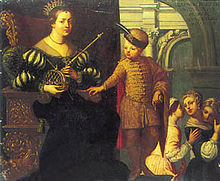
Bogislaw was the eldest son of Duke Barnim I by his first wife, sometimes said to be a daughter of King Eric X of Swede
|
John I, Lord of Werle-Parchim ( c. 1245 – 15 October 1283), was from 1277 to 1281 to Lord of Werle and from 1281 to 1283 and to Lord of Werle-Parchim.
He was the eldest son of Nicholas I and Jutta of Anhalt.
Sophia, the daughter of Count Günther of Lindow-Ruppin.
Henry I, Lord of Mecklenburg (nicknamed the Pilgrim, c. 1230 – 2 January 1302) ruled Mecklenburg from 1264 to 1275 and from 1299 until his death.
He was the eldest son of Lord John I. After his father's death, he at first ruled jointly with his brother Albert I. After Albert died in 1265, John ruled alone. Around 1259
he married Anastasia ( c. 1245 – 15 March 1317), the daughter of Duke Barnim I of Pomerania.
Vitslav II (ca. 1240 – 1302), variously called Vislav, Vizlav, Wislaw, Wizlaw and Witslaw in English sources ( German: Wizlaw II) was a prince of Rügen. [1]
|
Gerhard I, Count of Holstein-Itzehoe (1232 – 21 December 1290) was the only count of Holstein-Itzehoe.
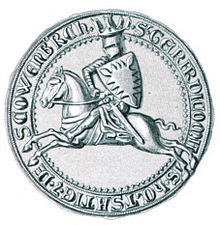
Elizabeth (d. c. 1280), a daughter of John I of Mecklenburg
John I, Lord of Werle-Parchim ( c. 1245 – 15 October 1283), was from 1277 to 1281 to Lord of Werle and from 1281 to 1283 and to Lord of Werle-Parchim.
He was the eldest son of Nicholas I and Jutta of Anhalt.
Sophia, the daughter of Count Günther of Lindow-Ruppin
Agnes of Brandenburg (c. 1257 – 29 September 1304) was a Danish Queen consort, spouse of King Eric V of Denmark. As a widow, she served as the regent of Denmark for her son Eric during his minority from 1286 until 1293.
Siemowit I of Masovia ( Polish: Siemowit (Ziemowit) I mazowiecki) (c. 1224/28 – 23 June 1262 [1]), was a Polish prince member of the House of Piast, Duke of Czersk during 1247-1248, Duke of Masovia (except Dobrzyń) during 1248-1262, ruler over Sieradz during 1259-1260
Traidenis (Polish: Trojden, Belarusian: Трайдзень) (died 1282) was the Grand Duke of Lithuania from 1270 (or 1269) till 1282. He is the second most prominent, after Mindaugas, Grand Duke of Lithuania in the 13th century. His reign ended a seven-year unrest period after Mindaugas was assassinated in 1263 and firmly established the Grand Duchy as a pagan state for another hundred years.
- Vitas (Rumunt or Roman) who also was nicknamed as the Wolf, son of Davil Rostislavich
Casimir I of Kuyavia ( Polish: Kazimierz I kujawski) (c. 1211 [1] – 14 December 1267), was a Polish prince member of the House of Piast, Duke of Kujawy since 1233, ruler over Ląd during 1239-1261, ruler over Wyszogród since 1242, Duke of Sieradz during 1247-1261, Duke of Łęczyca since 1247 and Duke of Dobrzyń since 1248.
With Ottokar's rule, the Přemyslids reached the peak of their power in the Holy Roman Empire. His expectations of imperial crown, however, were never fulfilled.
Named after his grandfather King Přemysl Ottokar I, he was originally educated for the role of an ecclesiastical administrator, while his elder brother Vladislaus was designated heir of the Bohemian kingdom. He was possibly educated by the Bohemian chancellor Philip of Spanheim, who would later become a rival for the rule in the Duchy of Carinthia.
Nothing is known about Agnes' early years. It is supposed that when Duchess Margaret of Austria married with Prince Přemysl Ottokar of Bohemia in 1252, she was part of her retinue as a lady-in-waiting.
Władysław of Opole ( Polish: Władysław opolski) ( c. 1225 – 27 August/13 September 1281/2) was a Duke of Kalisz during 1234–1244, Duke of Wieluń from 1234 to 1249 and Duke of Opole– Racibórz from 1246 until his death.
Konrad II of Czersk (pl: Konrad II czerski; ca. 1250 – 24 June 24/21 October 1294 [1]), was a Polish prince member of the House of Piast, Duke of Masovia during 1264-1275 jointly with his brother, since 1275 sole ruler over Czersk and Duke of Sandomierz during 1289.
Skalmantas or Skolomend is the name of a possible ancestor of the Gediminid dynasty. In 1975 historian Jerzy Ochmański noted that Zadonshchina, a poem from the end of the 14th century, contains lines in which two sons of Algirdas name their ancestors: "We are two brothers – sons of Algirdas, and grandsons of Gediminas, and great-grandsons of Skalmantas ( Skolomend)." This led to the hypothesis that Skalmantas was the long-sought ancestor of the Gediminids.
According to Synodik of Liubech, a duke Gomantas (who might have been this Skalmantas) had a daughter Helena (probably adult baptismal name, not original Lithuanian) who married the Chernihiv Rurikid princeling Andrew, duke of Kozelsk (died 1339, born perhaps in 1280s), an ancestral uncle of the Oginskis, Puzyna, Gortsakov, Yeletsky, Zvenigorodsky, Bolkhovskoy, Mosalsky and Khotetovsky princely lineages. The property listing of metropolitan Theognostus from mid-14th century reveals that duke Andrew Mstislavich of Kozelsk was married with a lady who was sister (or daughter) of king Gediminas.
Yaroslav III Yaroslavich (1230–1271) ( Russian: Ярослав Ярославич) was the first Prince of Tver and the tenth Grand Prince of Vladimir from 1264 to 1271. Yaroslav and his son Mikhail Yaroslavich presided over Tver's transformation from a sleepy village into one of the greatest centres of power in medieval Russia. All the later dukes of Tver descended from Yaroslav Yaroslavich.
Xenia of Tarusa ( Russian: Ксения Тарусская) ( c. 1246 - 1312), also known as Kseniya Yurievna ( Russian: Ксения Юрьевна), was a Princess consort of Tver and Grand Princess consort of Vladimir from 1267 to 1271. She is counted among the saints of the Russian Orthodox Church.
Xenia of Tarusa was a daughter of Youri Mikhailovich, Prince of Tarusa, by conflicting sources she could have been a daughter of Citizen Youri of Novgorod.
Dmitry Borisovich (Russian: Дмитрий Борисович; 11 September 1253, Rostov – 1294, Rostov) was a Russian nobleman. He was the eldest of the three sons of Prince Rostov Boris Vasylkovych from his marriage to Princess Maria Yaroslavna of Murom. He wasPrince of Rostov (1278–1286 and 1288–1294) and Prince of Uglich (1285–1288).
Sophia of Brandenburg-Stendal (1300-1356) was a daughter of Margrave Henry I (1256–1318) and his wife Agnes of Bavaria(1276–1345).
Bernhard III, Prince of Anhalt-Bernburg (died 20 August 1348) was a German prince of the House of Ascania and ruler of the principality of Anhalt-Bernburg.


Padres
John I, Count of Oldenburg ( c. 1204 – c. 1270) was a ruling Count of Oldenburg from 1233 until his death.
Richeza, a daughter of Count Henry II of Hoya,
|
Gerhard I, Count of Holstein-Itzehoe (1232 – 21 December 1290) was the only count of Holstein-Itzehoe.
Elizabeth (d. c. 1280), a daughter of John I of Mecklenburg
Gunzelin III, Count of Schwerin, also known as Günzel III of Schwerin, (d. after 23 October 1274) was Count of Schwerin from 1228 until his death.
Gunzelin III was the son of Count Henry I and his wife, Audacia
Barnim I the Good ( c. 1217/1219 – 13 November 1278) from the Griffin dynasty was a Duke of Pomerania ( ducis Slauorum et Cassubie) from 1220 until his death.
Albert was the oldest surviving son of the first Brunswick duke Otto the Child and his wife, Matilda of Brandenburg. When his father died in 1252, he took over the rule of the duchy; later his younger brother John joined him.

Vitslav II (ca. 1240 – 1302), variously called Vislav, Vizlav, Wislaw, Wizlaw and Witslaw in English sources ( German: Wizlaw II) was a prince of Rügen. [1]
Margrave Otto V of Brandenburg-Salzwedel (c. 1246 – 1298), nicknamed Otto the Tall, was a son of Margrave Otto III and co-ruler of Brandenburg with his cousin, Margrave Otto IV.
Judith of Henneberg-Coburg, a daughter of Count Herman I of Henneberg
Konrad I of Głogów ( Polish: Konrad I głogowski; 1228/31 – 6 August ca. 1274) was Duke of Głogów (Glogau) from 1251 until his death.
Salome of Greater Poland also known as Salomea Odonicówna (literally daughter of Odonic) ( Polish: Salomea Wielkopolska or Odonicówna; b. c. 1225 – d. April 1267?), was a Polish princess member of the Piast dynasty from the Greater Poland branch and by marriage Duchess of Glogów.
Bolko I the Strict also known as the Raw or of Jawor ( Polish: Bolko I Surowy[1] or Srogi or Jaworski; 1252/56 – 9 November 1301), was a Duke of Lwówek (Löwenberg) during 1278–81 (with his brother as co-ruler) and Jawor (Jauer) since 1278 (with his brother as co-ruler until 1281), sole Duke of Lwówek since 1286, Duke of Świdnica- Ziębice since 1291.


Henry II, Lord of Mecklenburg, nicknamed the Lion (after 14 April 1266 – 21 January 1329 in Sternberg) was regent of Mecklenburg from 1287 to 1298, co-regent from 1298 to 1302 and ruled alone again from 1302 to 1329.
- Born about 1297
- Deceased in June 1353 , age at death: possibly 56 years old
- Graf von Holstein-Pinneberg und Schauenburg
Parents
- Born in 1301
- Deceased in 1369 , age at death: 68 years old
Parents
|
|
Mikhail Yaroslavich was the second son of Yaroslav III (Yaroslav Yaroslavich), the younger brother of Aleksandr Nevsky, and succeeded him as Prince of Tver in 1285. His mother Xenia was the second spouse to Yaroslav III and is known as the saint Xenia of Tarusa.
Saint Anna of Kashin ( Russian: Святая благоверная великая княгиня - инокиня Анна Кашинская) (1280 – 2 October 1368) was a Russian princess from the Rurik Dynasty, who was canonized in 1650.
Henry IV, Count of Waldeck ( c. 1282/1290 – 1 May 1348) was the ruling Count of Waldeck from 1305 to 1344. He was the second ruling count named "Henry", which is why some authors call him "Henry II". However, two earlier non-ruling members of the House of Waldeck are usually called Henry II and Henry III, and the subject of this article is commonly called Henry IV.
He was the eldest son of Otto I and his wife Sophie, the daughter of Landgrave Henry I of Hesse.
Adelaide of Cleves (d. after 26 July 1327)
Matilda of Mecklenburg (1293–1358)

Henry, Count of Nassau (Dutch: Hendrik van Nassau-Siegen, German: Heinrich III. von Nassau) (before 1288 – July/August 1343) Count of Nassau-Siegen, of Grimborg, Heiger, Westerwald, later of Molsberg, and after his brother's death of Dillenburg. He was a son of Count Otto I of Nassau and Agnes of Leiningen.[1
Adelheid of Heinsberg, daughter of Dirk of Heinsberg and Blankenberg and Johanna of Leuven.
He was the son and heir of Count Eberhard II and his wife, Irmgard of Berg
Mechtilde ofArenberg (died March 18, 1328), daughter of Johann of Arenberg and Katharina of Jülich.
Dietrich VIII ( c. 1291 – 7 July 1347) was a German nobleman. He was Count of Cleves from 1310 through 1347.
John I, Lord of Polanen ( c. 1285 – 26 September 1342) was Lord of Polanen, Lord of De Lek and Lord of Breda.
He was a son of Philips III van Duivenvoorde en Elisabeth van Vianen

Federico III Wettin Wittelsbach
(Federico Wettin Wittelsbach) Federico III de Thuringia , Federico III el EstrictoLandgrave Thuringia (1349-1381), Margrave Meissen (1349-1381)
- Nacido el 14 de diciembre 1332 - Dresden, Sachsen, Deutschland
- Fallecido el 21 de mayo 1381 - Altenburg, Alemania , a la edad de 48 años
Padres
Enrique de Brunswick-Lüneburg (del latín Henricus, murió el 14 de octubre 1416), duque de Brunswick-Lüneburg, llamado Enrique el Apacible, fue príncipe de Lüneburgdesde 1388 a 1409, junto con su hermano Bernardo I de Brunswick-Lüneburg, desde 1400 hasta 1409 fue también príncipe de Wolfenbüttel, y desde 1409 hasta su muerte, el único príncipe de Lüneburg.
Rudolf VI of Baden (died 21 March 1372) was Margrave of Baden-Baden and Count of Eberstein from 1353 to 1372.
|
|
|
|
|
|
|
|




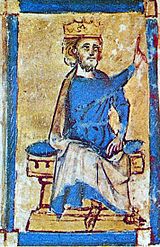
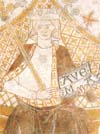









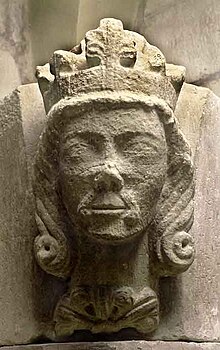
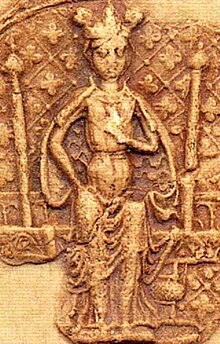


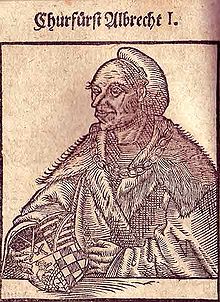







No hay comentarios:
Publicar un comentario